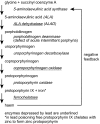Lead poisoning: case studies
- PMID: 11994050
- PMCID: PMC1874356
- DOI: 10.1046/j.1365-2125.2002.01580.x
Lead poisoning: case studies
Abstract
Early clinical features of lead toxicity are non-specific and an occupational history is particularly valuable. Lead in the body comprises 2% in the blood (t1/2 35 days) and 95% in bone and dentine (t1/2 20-30 years). Blood lead may remain elevated for years after cessation from long exposure, due to redistribution from bone. Blood lead concentration is the most widely used marker for inorganic lead exposure. Zinc protoporphyrin (ZPP) concentration in blood usefully reflects lead exposure over the prior 3 months. Symptomatic patients with blood lead concentration >2.4 micromol l-1 (50 microg dl-1) or in any event >3.8 micromol l-1 (80 microg dl-1) should receive sodium calciumedetate i.v., followed by succimer by mouth for 19 days. Asymptomatic patients with blood lead concentration >2.4 micromol l-1 (50 microg dl-1) may be treated with succimer alone. Sodium calciumedetate should be given with dimercaprol to treat lead encephalopathy.
Figures
References
-
- Browder AA, Joselow MM, Louria DB. The problem of lead poisoning. Medicine. 1973;52:121–139. - PubMed
-
- Waldron HA, Scott A. In: Hunter's Diseases of Occupations. Raffle PAB, Adams PH, Baxter PJ, Lee WR, editors. London: Edward Arnold; 1994. pp. 90–138.
-
- Approved Code of Practice. London: HMSO; 1985. Control of lead at work.
-
- London: The Stationery Office Ltd; 1998. Control of lead at work regulations.
-
- Department of Health and Human Services Agency for Toxic Substances and Disease Registry. Washington DC: Government Printing Office; 1988. The nature and extent of lead poisoning in children in the United States; pp. 1–13.
Publication types
MeSH terms
Substances
LinkOut - more resources
Full Text Sources
Medical


